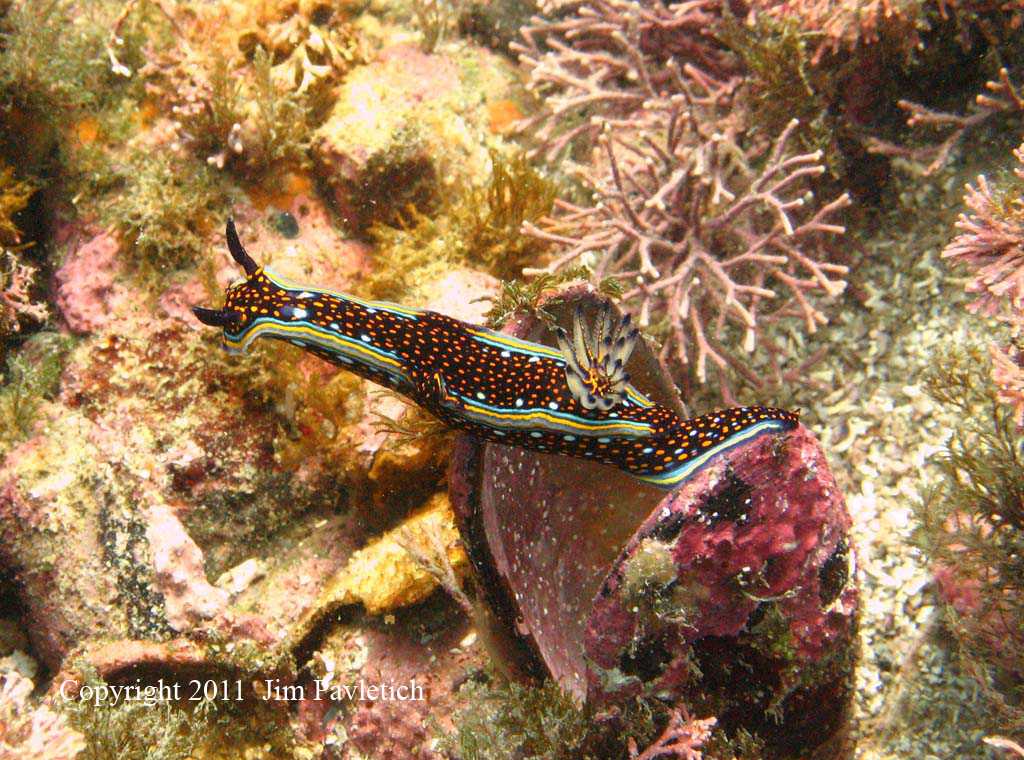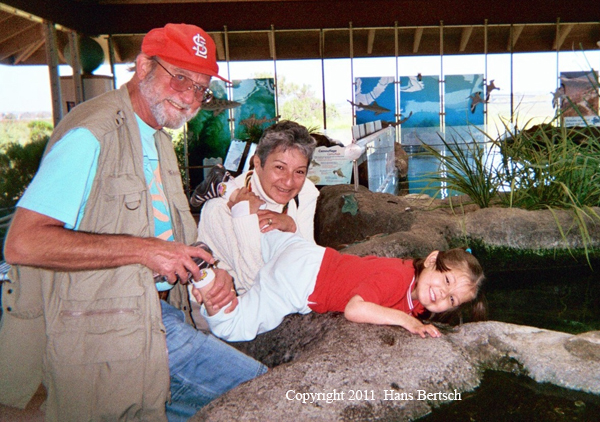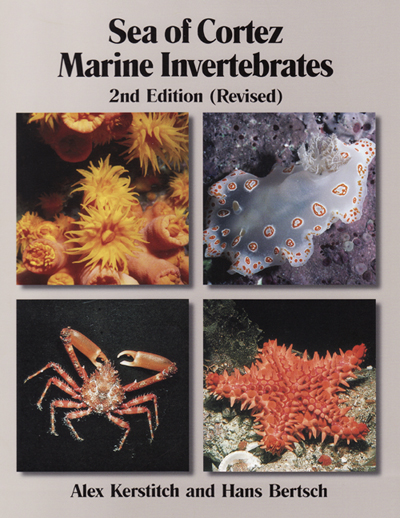 |
HYPSELODORIS AGASSIZII
:
Image courtesy of Jim Pavletich
Isla San Jorge, 20 miles southeast of Puerto Peñasco, Sonora, Mexico
3 September 2011, 15 feet depth
Canon Powershot A460, Canon UW case
Hypselodoris agassisii (Bergh, 1894)
Distributional ranges of species can be both deceiving and revealing. Extreme limital records may not reflect the preferred habitat, but on the other hand can indicate its natural history if carefully examined with long term studies.
This nudibranch species has been reported (Ferreira & Bertsch, 1975) to occur widely through the entire tropical eastern Pacific (sensu Keen, 1971). Its northernmost limit has been reported as Puerto Peñasco (31º 20' N; 113º 40' W), based on only one record, two specimens collected by George E. and Nettie MacGinitie in 1948 (Bertsch, 1978: 236). Other northern Gulf of California records are all from the Sonoran coast: Puerto Libertad (29º 54' N; 112º 41' W), Cabo Tepoca (30º 16' N; 112º 51' W), and from two sites in the Guaymas region (Marcus & Marcus, 1967: 176-177; Bertsch, 1978: 236). It should be emphasized that the Marcus & Marcus (1967: 176-178) discussion of “Hypselodoris californiensis,” compounds distributional data from three species: H. californiensis, H. agassizii, and H. ghiselini, but only describes dissections of the latter two species.
Jim Pavletich’s finding of H. agassizii near Puerto Peñasco, is hence quite significant, representing only the 2nd record from its northern distributional limit. The range of H. agassizii is from Puerto Peñasco, Sonora, Mexico, to Cancas, Tumbes, Perú (approximately 3º 56' S; 80º 56' W). For several decades its southernmost reported distribution had been the Islas Galápagos (0º 45' 05" N; 90º 15' 38" W) (see Sphon & Mulliner, 1972), but recently Nakamura (2006) extended its range southward 200+ miles (~330+ km) to Perú.
Description
Adult specimens of H. agassizii easily reach 70 mm in length; the largest I have observed ranged from 95-113 mm. The coloration pattern has similarities to that of H. ghiselini (sharing numerous small yellow dots on the indigo or dark blue notum, side of body, and top dorsal surface of the posteriorly-extending foot). Twice in the La Paz region, I have observed both species near each other during a single dive. The color differences are immediately apparent. Unique to H. agassizii are the light blue dots paired lengthwise on each side of the notum, and the marginal bands. The bands (light blue, dark blue, yellow and very light blue outermost) run lengthwise along the notal edge, excluding the anterior and posterior regions, and are interrupted midway along the body where the central notal yellow-spotted, deep purple color takes over. Rhinophores are typically deep indigo, with a whitish vertical streak posteriorly. The 10-14 tripinnate gills are creamish, tipped with an indigo or dark blue color on the distal tips. See Images (1), (2) and (3) . The inner basal portion of the gill plumes may also be dark blue with brilliant yellow spots.
The combined radular formula, based on counts from 23 radulae, is 47-80 (50-118.0.50-118) (see Bertsch, 1978).
Taxonomic History
Bergh (1894) originally described this species in the genus Chromodoris, but works by Bertsch (1977) and Rudman (1984) have more clearly delineated the genera within the Chromodorididae, and the bicuspid radular teeth and other features clearly place this species within the genus Hypselodoris.
Marcus & Marcus (1967) wrongly synonymized this species with the earlier H. californiensis (Bergh, 1879). Sphon (1971) correctly re-instated H. agassizii as a valid species.
Gosliner & Johnson (1999: 105) described the evolutionary relationships within this monophyletic genus. Atlantic and eastern Pacific species are a distinct clade (scientific talk for “related group”) from the central and Indo-Pacific species. Their hypothesized phylogeny shows the 4 east Pacific Hypselodoris species to be a distinct evolutionary grouping.
Zoogeography
Nineteen species of Chromodoridinae are known to occur along the shores of western North America, from Monterey Bay, California, to Islas Galápagos, Ecuador. They occur in four marine faunal provinces: Californian, Sea of Cortez (=Gulf of California), Mexican and Panamic (sensu Briggs, 1974). Some species occur in only one province, whereas others are reported from 2, 3 or all 4. Some species range more northerly in cool temperate waters (e.g., Chromodoris norrisi and H. californiensis), whereas others are southerly tropical water denizens (e.g. C. sphoni and H. agassizii).
Animal abundance, not just numbers of species, provides a better understanding of the structure and function of ecosystems (Bertsch, 2011). Long term data sets from BLA and the La Paz region in the Gulf, and Bahía de Banderas (BB), Jalisco-Nayarit, Mexican Pacific coast, show the relative north-south abundances of Chromodoridinae (see Table II). I have found that at BLA, “tropical” species C. sphoni, C. sedna and Mexichromis antonii are absent, just as Alicia Hermosillo found that the “temperate” species H. californiensis is absent at BB. At BLA, 8 species constitute 2% of the total nudibranch fauna observed, contrasting with the more tropical La Paz and BB sites where they are 18-20% of the nudibranch fauna. Farther south, numbers of individual species account for more of the chromodoridine abundance than all of these species at BLA. At La Paz, G. dalli and H. ghiselini account for 3.39% and 4.84% respectively of all nudibranchs. At BB, G. sedna and H. agassizii account for a whopping 5.34% and 8.61% respectively of the nudibranchs!
The Gulf of California extends over 850 miles, and it has been divided into various faunal areas, corresponding to the distributions of different taxa: Northern, Central and Southern Gulf (see Findley & Brusca, 2005), and Midriff Islands (see Lindsay & Engstrand, 2002). Just as range limits in California (with a border-to-border length of some 800 miles) are given by specific sites (such as Monterey Bay), so also should be listed range limits from the Gulf of California (e.g., Puerto Peñasco, not “Gulf of California”).
These faunal regions also correspond in part with the seasonally varying temperature regimes within the Gulf. Puerto Peñasco and Bahía de los Ángeles (BLA) have the greatest surface sea water temperature variation in the Gulf, from lows of 58-60º F in January and February, to highs of 84-87º F in September (Robinson, 1973). In contrast, the temperatures in the La Paz region vary from 65º to 86º F during those same months. These seasonal changes in temperature correspond to changes in the structure and composition of the species compositions at both Puerto Peñasco and BLA (Bertsch, 2008; Bertsch & Marlett, 2011; and pers. obser.).
Hypselodoris agassizii is common southward from La Paz, BCS. It has been reported on the Sonoran coast in the northern Gulf of California (albeit rarely), but not at BLA (on the Baja California coastline). This distributional pattern is shared with Glossodoris sedna, which, however, “is the most common nudibranch at Puerto Peñasco. It is present throughout the year, but may be locally abundant during August” (Marcus & Marcus, 1967: 178; quoting Peter E. Pickens, University of Arizona, Tucson, based on intertidal colelctions between 1964-1966 in the intertidal zone of the northeastern part of the Gulf of California). During more than 25 years of ecological monitoring of the nudibranch communities at BLA (Midriff region, west-central Gulf of California), I have never observed H. agassizii nor G. sedna.
Long term monitoring studies (annual and seasonal) along the Sonoran coastline are needed to determine variation in spatio-temporal patterns related to water temperature changes. Does the occurrence of “tropical” species in summer (e.g., August) at Puerto Peñasco follow a temporal progression northward from the south? Lack of long term historical data from the Sonoran coastline may prohibit correlations with global climatic change, as has been demonstrated for the coast of California (Goddard et al., 2011; Schultz et al., 2011).
Literature Cited (including references for Tables I and II)
Angulo Campillo, Orso Juan. 2003. Variación Espacio-Temporal de las Poblaciones de Opistobranquios (Mollusca: Opisthobranchia) en Tres Localidades de B.C.S., México. Master’s Thesis, Instituto Politécnico Nacional, Centro Interdisciplinario de Ciencias Marinas, La Paz, B.C.S. 65 pp.
Behrens, David W. & Alicia Hermosillo. 2005. Eastern Pacific Nudibranchs: A Guide to the Opisthobranchs from Alaska to Central America. Monterey, California: Sea Challengers. vi + 137 pp.
Bergh, Ludwig Sophus Rudolph. 1894. Die Opisthobranchien. Reports on the dredging operations off the west coast of Central America to the Galápagos, to the west coast of Mexico, and in the Gulf of California, in charge of Alexander Agassiz, etc. Bulletin Museum Comparative Zoology, Harvard 25 (10): 125-233.
Bertsch, Hans. 1977. The Chromodoridinae nudibranchs from the Pacific coast of America. Part I. Investigative methods and supra-specific taxonomy. The Veliger 20 (2): 107-118.
Bertsch, Hans. 1978. The Chromodoridinae nudibranchs from the Pacific coast of America. Part IV. The genus Hypselodoris. The Veliger 21 (2): 236-250.
Bertsch, Hans. 1988. Anatomy and zoogeography of Glossodoris sedna and Chromodoris grahami (Opisthobranchia: Nudibranchia) in the tropical eastern Atlantic and Caribbean. The Veliger 30 (4): 395-399.
Bertsch, Hans. 2008. Opistobranquios. In: Gustavo D. Danemann & Exequiel Ezcurra (eds.), Bahía de los Ángeles: Recursos Naturales y Comunidad. Línea Base 2007. SEMARNAT, Pronatura Noroeste, SDNHM & INE: Capítulo 11: 319-338.
Bertsch, Hans. 2010. Biogeography of northeast Pacific opisthobranchs: Comparative faunal province studies between Point Conception, California, USA, and Punta Aguja, Piura, Perú. In: Luis José Rangel Ruíz et al. (eds.), Perspectivas en Malacología Mexicana. Villahermosa, Tabasco: Universidad Juárez Autónoma de Tabasco, Mexico. pp. 219-259.
Bertsch, Hans. 2011. Nudibranch feeding biogeography: Ecological network analysis of inter- and intra-provincial variations. Thalassas 27 (2): 155-168.
Bertsch, Hans & Cathy Moser Marlett. 2011. The Seris, the sun and slugs: Cultural and natural history of Berthellina ilisima and other Opisthobranchia in the central Sea of Cortez. Thalassas 27 (2): 9-21.
Briggs, John C. 1974. Marine Zoogeography. New York: McGraw-Hill. 475 pp.
Camacho-García, Yolanda, Terrence M. Gosliner & Ángel Valdés. 2005. Guía de Campo de las Babosas Marinas del Pacífico Este Tropical (Field Guide to the Sea Slugs of the Tropical Eastern Pacific). San Francisco: California Academy of Sciences. 129 pp.
Ferreira, Antonio J. & Hans Bertsch. 1975. Anatomical and distributional observations on some opisthobranchs from the Panamic faunal province. The Veliger 17 (4): 323-330.
Findley, Lloyd T. & Richard C. Brusca. 2005. Presentación de datos (Presentation of data). In: Michel E. Hendrickx, Richard C. Brusca & Lloyd T. Findley (eds.), Listado y Distribución de la Macrofauna del Golfo de California, México (A Distributional Checklist of the Macrofauna of the Gulf of California, Mexico). Tucson, Arizona: Arizona-Sonora Desert Museum. pp. 25-40.
Goddard, Jeffrey H. R., Terrence M. Gosliner & John S. Pearse. 2011. Impacts associated with the recent range shift of the aeolid nudibranch Phidiana hiltoni (Mollusca, Opisthobranchia) in California. Marine Biology 158 (5): 1095-1109. (Also available Online at Springerlink.com: DOI 10-1007/s00227-011-1633-7)
Gosliner, Terrence M. & Rebecca F. Johnson. 1999. Phylogeny of Hypselodoris (Nudibranchia: Chromodorididae) with a review of the monophyletic clade of Indo-Pacific species, including descriptions of twelve new species. Zoological Journal of the Linnean Society 125: 1-114.
Hermosillo González, Alicia. 2006. Ecología de los Opistobranquios (Mollusca) de Bahía de Banderas, Jalisco-Nayarit, México. Ph.D. Thesis, Universidad de Guadalajara, Centro Universitario de Ciencias Biológicas y Agropecuarias. 151 pp.
Hermosillo, Alicia, David W. Behrens & Eduardo Ríos Jara. 2006. Opistobranquios de México. Guía de Babosas Marinas del Pacífico, Golfo de California y las Islas Oceánicas. México: CONABIO. 143 pp.
Keen, A. Myra. 1971. Sea Shells of Tropical West America. Marine Mollusks from Baja California to Peru. Stanford, California: Stanford University Press. 1064 pp.
Kerstitch, Alex & Hans Bertsch. 1988. Mexichromis tura: Range extension of a rarely observed nudibranch. The Veliger 30 (4): 421.
Lindsey, George E. & Iris H. W. Engstrand. 2002. History of scientific exploration in the Sea of Cortés. In: Ted J. Case, Martin L. Cody & Exequiel Ezcurra (eds.), A New Island Biogeography of the Sea of Cortés. New York: Oxford University Press. pp. 3-13.
Marcus, Eveline & Ernst Marcus. 1967. American Opisthobranch Mollusks. Miami: Studies in Tropical Oceanography 6: 1-256.
Nakamura, Katia. 2006. New records of opisthobranch mollusks from the Guayaquil Marine Ecoregion: Northern Perú. The Festivus 38 (7): 75-83.
Robinson, Margaret K. 1973. Atlas of monthly mean sea surface and subsurface temperatures in the Gulf of California, Mexico. San Diego Society of Natural History, Memoir 5: 19 pp. & 90 figs.
Rudman, William B. 1984. The Chromodorididae (Opisthobranchia: Mollusca) of the Indo-West Pacific: A review of the genera. Zoological Journal of the Linnean Society 81 (2/3): 115-273.
Schultz, Stewart T., et al. 2011. Climate-index response profiling indicates larval transport is driving population fluctuations in nudibranch gastropods from the northeast Pacific Ocean. Limnology & Oceanography 56 (2): 749-763. (Also available Online: DOI 10.4319/lo.2011.56.2.0749)
Sphon, Gale G. 1971. The reinstatement of Hypselodoris agassizii (Bergh, 1894) (Mollusca: Opisthobranchia). The Veliger 14 (2): 214.
Sphon, Gale G. & David K. Mulliner. 1972. A preliminary list of known opisthobranchs from the Galápagos Islands collected by the Ameripagos Expedition. The Veliger 15 (2): 147-152.
Hans Bertsch
Imperial Beach, California
WEBMASTER'S NOTES: The Webmaster would like to thank Jim Pavletich of Tucson, Arizona for getting the ball rolling on this presentation in the first place. His astute observations as to the presence of Hypselodoris agassizii in the Puerto Penasco, Sonora area of the Sea of Cortez is invaluable information for researchers like Dr. Hans Bertsch! Once again, underwater photographers come to the forefront in our never ending quest to better understand our sea slug friends!
 |
Hans Bertsch and Rosa Campay, with their 5 year old granddaughter Ivette Cadena at the Chula Vista Nature Center manta ray touch tank. It's safer for Ivette to touch the rays here than at the beach in the Gulf of California. While this BOW goes online, Hans and Rosa are in the Gulf of California to dive for nudibranchs at Bahia de los Angeles, and to celebrate his birthday on the Day of the Dead! Hans is wearing his St. Louis Cardinals' baseball hat and now is also celebrating an early birthday present---their winning the 2011 World Series. |
 |
Personally autographed copies of Sea of Cortez Marine Invertebrates, 2nd edition, are available from Hans.
Send Hans email at hansmarvida@sbcglobal.net to order or obtain more information! |
